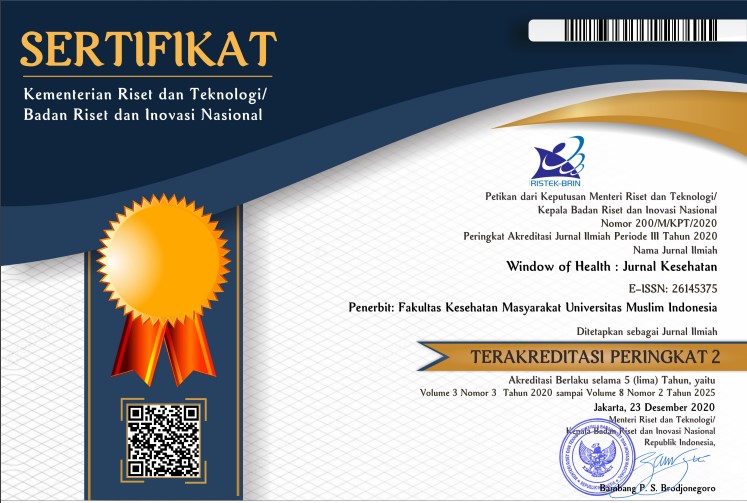Determinants of Community Participation in the COVID-19 Vaccination Program
Abstract
Coronavirus Disease 2019 (COVID-19) is an infectious disease caused by the SARS-CoV-2 virus, which is transmitted mainly through saliva or secretions from the nose when an infected person coughs or sneezes. One way to prevent the broader spread of the COVID-19 pandemic is by vaccination. The study aimed to determine factors related to community participation in the COVID-19 vaccination program in Batu Merah State, Ambon City, in 2021. This study was an analytical study using primary data with a cross-sectional approach. The sample in this study consisted of residents of Batu Merah State, Ambon City, aged 18 years, totaling 204 people who were taken using the cluster random sampling technique. 59 respondents (28.9%) had received the first dose of vaccination, and as many as 42 respondents (20.6%) had received the first and second doses of vaccination. Meanwhile, as many as 103 respondents (50.5%) have not been vaccinated. The role of the environment is mainly found in the supportive category, which is 136 respondents (66.7%), the most motivation is in the medium category, which is 125 respondents (61.3%), the most economical level is in the lower middle category as many as 117 respondents ( 57.4%), the highest confidence was in the medium category, which was 110 respondents (53.9%), and the most convenience was in the relatively easy category, which was 163 respondents (79.9%). There is a relationship between the role of the environment, motivation, economic level, confidence, and convenience with community participation in the COVID-19 vaccination program in Batu Merah State, Ambon City, in 2021. Suggestion to Batu Merah people who have not been vaccinated to come to the nearest health center.
References
2. World Health Organization. Naming The Coronavirus Disease (COVID-19) and The Virus That Causes It. [Internet]. 2020 [cited 11 November 2020]. Available from: https://www.who.int/emergencies/diseases/novel-coronavirus-2019/technical-guidance/naming-the-coronavirus-disease-(covid-2019)-and-the-virus-that-causes-it
3. Kementerian Kesehatan RI, Direktorat Jenderal Pencegahan dan Pengendalian Penyakit (P2P). Pedoman Pencegahan dan Pengendalian Corona Virus Disease (COVID-19). Pedoman kesiapan menghadapi COVID-19 [Internet]. 2020;1–116. Available from:https://covid19.go.id/p/protokol/pedoman-pencegahan-dan-pengendalian-coronavirus-disease-covid-19
4. World Health Organization. COVID-19 Weekly Epidemiological Update 63. World Heal Organ [Internet]. 2021;1–23. Available from:https://www.who.int/publications/m/item/weekly-epidemiological-update---26-october-2021
5. Satuan Tugas Penanganan COVID19. ANALISIS DATA COVID-19 INDONESIA Update Per 17 Oktober 2021. 2021;1–330. Available from:
https://covid19.go.id/p/berita/analisis-data-covid-19-indonesia-update-17-oktober-2021
6. Satuan Tugas Percepatan Penanganan COVID-19 Kota Ambon. Data sebaran kasus COVID-19 per Desa/Kelurahan/Negeri. [Internet] 2021. [cited 31 Oktober 2021]. Available from: https://ambon.go.id/covid-19/
7. Hidayani RW. Faktor-faktor Resiko yang Berhubungan Dengan COVID-19: Literature Review. JUKMAS. 2020;4(2):121.
Available from:http://ejournal.urindo.ac.id/index.php/jukmas/article/view/1015/696
8. Tim BPS Covid-19 Statistical Task Force. Hasil Survei Perilaku Masyarakat Di Masa Pandemi Covid-19 (7-14 September 2020) [Internet]. Vol. 19, Perilaku Masyarakat di Masa Pandemi Covid-19 BPS RI. 2020. 1–50 p. Available from:
https://www.bps.go.id/publication/2020/09/28/f376dc33cfcdeec4a514f09c/perilaku-masyarakat-di-masa-pandemi-covid-19.html
9. Sari IP, Sriwidodo. Perkembangan Teknologi Terkini dalam Mempercepat Produksi Vaksin COVID-19. Maj Farmasetika [Internet]. 2020;5(5):204–17. Available from: http://jurnal.unpad.ac.id/farmasetika/article/view/28082
10. Kementerian Kesehatan Republik Indonesia, WHO, UNICEF. Survei Penerimaan Vaksin COVID-19 di Indonesia. Satuan Gugus Tugas Penanganan COVID-19 [Internet]. 2020;(17 November):5–6.
Available from: https://covid19.go.id/p/hasil-kajian/covid-19-vaccine-acceptance-survey-indonesia
11. Sunstein C, Altieri E, Kim M, Carrasco M, Chadborn T, Gauri V, et al. Behavioural considerations for acceptance and uptake of COVID-19 vaccines [Internet]. World Health Organisation (WHO). 2020.
Available from: https://www.who.int/publications/i/item/9789240016927
12. Succi MDCR. Vaccine refusal - what we need to know. J Pediatr (Rio J). 2018;94(6):574–81. Available from:
https://pubmed.ncbi.nlm.nih.gov/29654748/
13. MacDonald EN, The SAGE Working Group on Vaccine Hesitancy. Vaccine hesitancy : Definition , scope and determinants. Vaccine. 2015;33:4161–4. Available from:
https://pubmed.ncbi.nlm.nih.gov/25896383/
14. The Sage Working Group on Vaccine Hesitancy. Vaccine Hesitancy Survey Questions Related to SAGE Vaccine Hesitancy Matrix. [Internet]. 2021 [cited on 20 Juni 2021]. Available from:
https://www.who.int/immunization/programmes_systems/Survey_Questions_Hesitancy.pdf
15. Fauziah R. Motivasi Ibu Dalam Pemberian Imunisasi Dasar. Medan: Universitas Sumatera Utara;2014.
16. Yan E, Lai LWD, Lee PWV. Predictors of Intention to Vaccinate against COVID-19 in the General Public in Hong Kong: Findings from a Population-Based, Cross-Sectional Survey [Internet]. 2021 [cited on 31 Oktober 2021]. Available from:
https://www.mdpi.com/2076-393X/9/7/696/htm
17. Sumiarto. Perumahan dan pemukiman, sejarah dan tantangan di depan. Jakarta: Forum perencanaan pembangunan;1993.
18. Widiastuti YP dkk. Analisis faktor yang berhubungan dengan perilaku ibu dalam memberikan imunisasi dasar kepada bayinya di desa Banyutowo Kabupaten Kendal. Jurnal PDII [internet]. 2008 [cited on 24 Oktober 2021]; 1(1):1-24. Tersedia dari: http://jurnal.pdii.lipi.go.id/admin/jurnal/ 1108714.pdf
19. Chew NWS, Cheong C, Kong G, Phua K, Ngiam JN, Tan BYQ, dkk. An Asia-Pacific study on healthcare workers’ perceptions of, and willingness to receive, the COVID-19 vaccination. International Journal of Infectious Diseases. 2021;106:52–60. Available from:
https://doi.org/10.1016/j.ijid.2021.03.069
20. Scientific Advisory Group for Emergencies (SAGE). Factors influencing COVID-19 vaccine uptake among minority ethnic
groups. [Internet]. 2021 [cited on 5 Oktober 2021]. Available from:
https://assets.publishing.service.gov.uk/government/uploads/system/uploads/attachment_data/file/952716/s0979-factors-influencing-vaccine-uptake-minority-ethnic-groups.pdf








